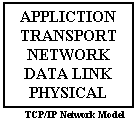
Chris Palmer
Basics of Networking
This paper is designed as an introduction to those who know little to nothing about computer networks and networking, but are familiar with computers themselves. This chapter will contain information on the basic OSI model (see below) of networking as well as some TCP/IP information. I'm probably not going to branch in to too many specifics as far as different operating systems, etc. My concentration is on Ethernet systems, although TCP/IP should be universal to any platform (that's the whole point).
One of the easiest ways to talk about networks is using the Open Systems Interface (OSI) model. This is the model that, in theory, all computer networking systems should follow. It was developed so that anyone designing and talking about networks would have a common "language." TCP/IP differs a little bit, but that will be covered later. The model itself is a seven tiered column, with the user sitting on the very top, and whatever s/he is communicating with on the very top of another, identical column. The details differ from machine to machine, but the overall structures should be the same.
The top three layers are grouped together to form the "User Support" group, which means that they are responsible for things a lot more towards the application side. The last three layers are "Network Support" and they are responsible for making the data into a universally legible form and transforming it into actual network signals that pulse along the network connection itself (which can be fiber, cable, or even wireless). The Transport Layer is stuck in the middle of the two groups and is responsible for translating between them.

Each layer has it's own set of responsibilities, and together they are able to take user/computer input and transform it into electronic code and back again. What follows is a list of each layer and a short description:
That's it for the OSI model. There are lots of details in each layer (Manchester vs. Differential Manchester vs.... encoding, etc.) but the end result should look like this. Note that the IEEE divides the Data Link layer into two other layers:
That's about as far into the OSI model as I'm going to go. The only thing to add is that the physical layer is often influenced a lot by the topology of the network. The topology is simply the pattern in which the computers are laid out. There are three main ones: linear, ring and star. A linear topology is all of the computers (this includes all file servers, printers, etc.) are daisy chained together, A into B into C... with the ends just terminating. While this topology is very easy to set up, it's only advantages are the low length of cable (assuming that's what's being used) and it's initial installation speed. If one computer goes down, the network is bisected into two parts which can no longer communicate with one another, and there is no redundancy. Coax cable is usually used for linear topologies. The ring topology is better; the computer form a "ring" so that A goes to B goes to C...goes to A. Only a little more cable is needed to setup, but there is a lot more redundancy (if one computer goes down, just traverse the ring in the opposite rotation). Token Ring networks are setup this way. The last topology is star in which (big surprise here), everything is set up like a star. This means that there is a central server and each computer is connected directly into it. Variations of this include having routers or gateways that act as mini-hubs so that the star begins to look more like a collection of linked stars, but the idea is similar. This requires much more cable than the other two, and consequently more setup time but errors are very easy to trace and if a computer goes down it's totally irrelevant to the rest of the network. The only exceptions of course being the central server(s), which will disconnect all the computers linked to them if they crash. Ethernet systems are usually star topologies.
Most of the Internet runs on a suite of protocols known as TCP/IP. The details of this are covered in TCP and UDP Protocols and IP Protocol, but it's important to know that TCP/IP doesn't follow the OSI model. TCP/IP was created for Unix before the OSI model was created, so while it's very similar there are some differences.

The list is similar to the OSI model, but with a few of the inner layers merged. Below the layers are explained more fully.
Move on to TCP.
return to the index
Send comments to: Ardenstone@Ardenstone.com